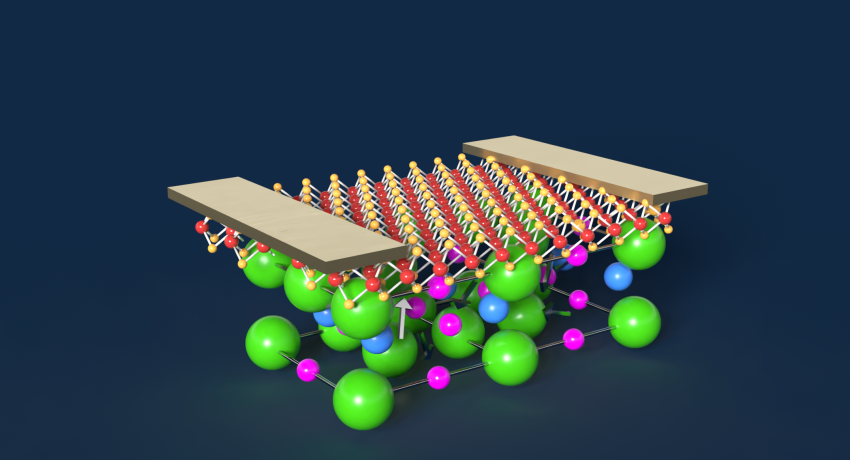Combining ultra-thin molybdenum disulfide with flexible strontium titanate nanomembranes creates advanced materials that can be used in a variety of low-power, high-performance electronic and sensing devices. Credit: Jennifer M. McCann. All Rights Reserved.
By Jamie Oberdick
Scientists at Penn State have harnessed a unique property called incipient ferroelectricity to create a new type of computer memory that could revolutionize how our devices work, such as using much less energy and being able to work in extreme environments like outer space.
The researchers noted that the societal benefits of this research could be significant. Traditional AI systems, especially those handling image recognition, consume significant energy. The ferroelectric transistors’ low power requirements present a sustainable alternative.
“AI accelerators are notoriously energy-hungry,” Harikrishnan Ravichandran, a doctoral student in engineering science and mechanics and co-author of the study, said. “Our devices switch rapidly and consume far less energy, paving the way for faster, greener computing technologies.”
Their study, published in Nature Communications, focuses on multifunctional two-dimensional field-effect transistors (FETs) that leverage incipient ferroelectricity—a previously overlooked property—within freestanding strontium titanate nanomembranes.
FETs are advanced electronic devices that use ultra-thin layers of materials to control electrical signals, offering multiple functions like switching, sensing or memory in a compact form. Incipient ferroelectricity refers to materials that show signs of temporary, scattered polarization, meaning parts of it can switch charges like tiny dipoles but it does not settle into a stable state under normal conditions.
Think of it like a material that is almost, but not quite, ferroelectric. It has the potential to become ferroelectric, but it needs a little push. That is kind of what incipient ferroelectricity is -- a material that is on the verge of becoming ferroelectric, meaning it can hold an electrical charge, but needs certain conditions to make that happen.
“Incipient ferroelectricity means there’s no stable ferroelectric order at room temperature,” Dipanjan Sen, doctoral candidate in engineering science and mechanics and lead author in the study, said. “Instead, there are small, scattered clusters of polar domains. It’s a more flexible structure compared to traditional ferroelectric materials.”
While this trait is often considered a limitation, the team found ways to harness incipient ferroelectricity for possible new applications. According to Ravichandran, the devices displayed unique behaviors across temperature ranges.
“The main goal of the project was to explore whether incipient ferroelectricity, usually seen as a disadvantage because it leads to short memory retention, could actually be useful,” said Saptarshi Das, Ackley Professor of Engineering and Professor of Engineering Science and Mechanics at Penn State and corresponding author of the study. “At cryogenic conditions, this material exhibited traditional ferroelectric-like behavior suitable for memory applications. But what we saw at room temperature, this property behaved differently. It had this relaxor nature.”
Relaxer behavior refers to a more disordered, short-range polarization response. This type of behavior is less predictable and more fluid, which contrasts with the stable, long-range order seen in traditional ferroelectrics. This means the material's ferroelectric properties are weaker or less stable at room temperature. Instead of being a drawback, it showed potential for use in neuromorphic computing, which aims to imitate how the human brain processes information using neurons and uses much less energy than traditional computers. Like our brain, it saves energy by only using power when needed, like flipping a light switch on and off, instead of staying on all the time like traditional computers.
“These devices acted like neurons, mimicking biological neural behavior,” said Mayukh Das, doctoral candidate in engineering science and mechanics and study co-author. “To test we performed a classification task using a grid of three-by-three pixel images fed into three neurons. The devices were able to classify each image into different categories. This learning method could eventually be used for image identification and classification or pattern recognition. Importantly, it works at room temperature, reducing energy costs. These devices function similarly to the nervous system, acting like neurons and creating a low-cost, efficient computing system that uses a lot less energy.”
Strontium titanate is typically non-ferroelectric. However, freestanding nanomembranes of strontium titanate exhibit polar order, as confirmed by second harmonic generation experiments. Notably, it started to exhibit ferroelectric-like behavior, especially at very low temperatures due to reduced thermal fluctuations.
Strontium titanate thin films, along with its incipient ferroelectricity, is also a perovskite material. Perovskites, materials with a specific type of crystal structure, are valued for their exceptional electronic properties.
“We were surprised to see that these well-known perovskite materials could exhibit exotic ferroelectric properties at the device level,” Sen said. “It wasn’t something we anticipated, but once we started fabricating the devices, we saw behaviors that could really redefine advanced electronics.”
Using molecular beam epitaxy, a technique that involves depositing a layer of atoms on a substrate to form a thin film, researchers at the University of Minnesota grew the strontium titanate films. These were then combined with molybdenum disulfide, a well-established two-dimensional material. Together, these materials created FETs with innovative functionalities, including incipient ferroelectricity.
The researchers noted that future research will include solving current challenges such as scalability and commercial viability while exploring other potential materials.
“Right now, this is at the research and development stage,” Sen said. “Perfecting these materials and integrating them into everyday devices like smartphones or laptops will take time, so there’s so much more to explore. In addition, we’re examining other perovskite materials, like barium titanate, to uncover their potential. The opportunities for growth are immense, both in materials and device applications.”
Along with Sen, Das and Ravichandran, other authors of the study include from Penn State Saptarshi Das, corresponding author and Ackley Professor of Engineering and professor of engineering science and mechanics; Pranavram Venkatram, graduate student in engineering science and mechanics; Zhiyu Zhang, graduate student in engineering science and mechanics; Yongwen Sun, graduate student in engineering science and mechanics; Shiva Subbulakshmi Radhakrishnan, graduate student in engineering science and mechanics; Akash Saha, graduate student in materials science and engineering; Sankalpa Hazra, graduate student in materials science and engineering; Chen Chen, assistant research professor, thin films in the Two-Dimensional Crystal Consortium (2DCC-MIP); Joan Redwing, director of the 2DCC-MIP and distinguished professor of materials science and engineering and of electrical engineering; Venkat Gopalan, professor of materials science and engineering and of physics; and Yang Yang, assistant professor of engineering science and mechanics and of nuclear engineering. From the University of Minnesota, co-authors of the study include Sooho Choo, Shivasheesh Varshney, Jay Shah, K. Andre Mkhoyan and Bharat Jalan.
The work was supported by the National Science Foundation and the Army Research Office.

